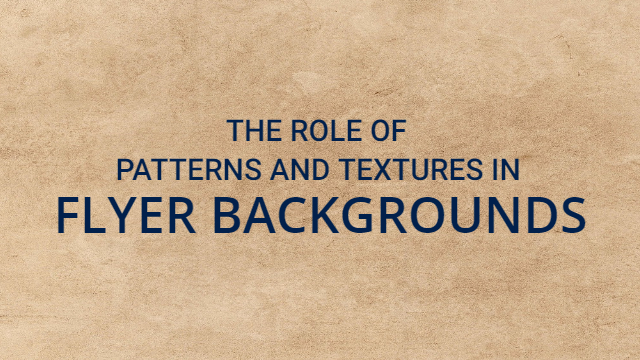Flyers are a popular way to spread information and capture people’s attention. They are used for various purposes, such as promoting events, advertising products, or sharing important messages. When designing a flyer, one crucial element to consider is the background. Patterns and textures play a significant role in enhancing the overall visual appeal and effectiveness of a flyer. In this blog, we will explore the importance of patterns and textures in flyer background and how they can make a flyer more engaging and appealing to the audience.
Why are patterns and textures important in flyer backgrounds?
Visual Interest:
Patterns and textures add visual interest to flyer backgrounds. A plain, solid color background might appear dull and unattractive. By incorporating patterns or textures, designers can make the flyer visually appealing and draw the attention of viewers.
Enhancing Message:
Patterns and textures can help convey the message or theme of the flyer more effectively. For example, if the flyer is for a beach party, using a background with a wave pattern or a sandy texture can instantly evoke the feeling of being at the beach. It helps create a connection between the visual elements and the intended message of the flyer.
Branding and Identity:
Patterns and textures can be used strategically to reinforce a brand or organization’s identity. By incorporating unique patterns or textures associated with the brand, the flyer becomes more recognizable and helps build a consistent visual identity.
Creating Hierarchy:
Patterns and textures can be used to create a visual hierarchy in the flyer design. By using contrasting patterns or textures, designers can guide the viewer’s eye toward the most important information or call to action, ensuring that the message is conveyed effectively.
Evoking Emotions:
Different patterns and textures have the power to evoke specific emotions. For instance, using a soft, pastel-colored floral pattern can create a sense of calm and tranquility, while bold and vibrant geometric patterns can evoke excitement and energy. By carefully selecting the right patterns and textures, designers can create an emotional connection with the audience.
Examples of Patterns and Textures in Flyer Backgrounds:
Nature-inspired:
Flyer backgrounds can feature patterns and textures inspired by nature, such as leaves, flowers, or landscapes. These elements can be used for environmental campaigns, gardening events, or outdoor activities.
Grunge or Vintage:
Grunge or vintage textures can be used to give a flyer a retro or edgy look. This style is often employed for music concerts, artistic events, or alternative lifestyle promotions.
Abstract and Geometric:
Abstract or geometric patterns can add a modern and contemporary feel to a flyer. They are suitable for technology-related events, art exhibitions, or design showcases.
Textured Paper:
Simulating the texture of different types of paper, such as parchment or recycled paper, can give a flyer a tactile and organic feel. This style is commonly used for events related to literature, history, or eco-friendly initiatives.
Watercolor or Brush Strokes:
Using watercolor or brush stroke textures can create a painterly effect in flyer backgrounds. This approach is often employed for art workshops, painting classes, or exhibitions.
FAQs:
Q1. What is the difference between patterns and textures?
Patterns refer to repeated elements or motifs arranged in a specific order, while textures pertain to the tactile quality or surface appearance of an object.
Q2. Can I use multiple patterns or textures in a flyer background?
Yes, you can combine multiple patterns or textures in a flyer background. However, it is essential to ensure that they complement each other and do not overwhelm the overall design.
Q3. How can I choose the right patterns and textures for my flyer?
Consider the purpose and message of your flyer. Look for patterns and textures that align with the theme or evoke the desired emotions. Experiment with different combinations to find the one that best represents your content.
Q4. Are there any resources for finding patterns and textures for flyer backgrounds?
Yes, several websites offer free or paid patterns and textures that you can download and use in your flyer designs. Some popular resources include Freepik, Vecteezy, and TextureKing.
Conclusion:
Patterns and textures are essential design elements that significantly contribute to the effectiveness of flyer backgrounds. They add visual interest, enhance the message, and create a connection with the audience. By carefully selecting and combining patterns and textures, designers can create engaging and memorable flyers that capture attention and effectively communicate the intended message. So, next time you design a flyer, don’t forget to explore the creative possibilities that patterns and textures offer.
Also Read:- Flyer Backgrounds for Every Occasion: From Corporate to Casual


